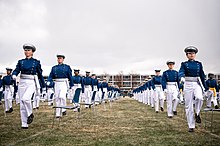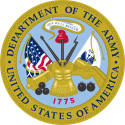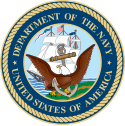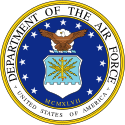United States Space Force
 Pieczęć Sił Kosmicznych Stanów Zjednoczonych | |
| Państwo | |
|---|---|
| Siły zbrojne | |
| Nazwa skrócona | USSF |
| Data utworzenia | 20 grudnia 2019[1] |
| Proporzec | |
| Liczebność | 88[2] |
| Najwyższe dowództwa | |
| Cywilne | Prezydent Stanów Zjednoczonych |
| Wojskowe | szef operacji kosmicznych gen. John W. Raymond |

United States Space Force (USSF) – Siły Kosmiczne Stanów Zjednoczonych, jeden z 6 rodzajów Sił Zbrojnych Stanów Zjednoczonych. Są pierwszym wydzielonym rodzajem sił zbrojnych od czasów uniezależnienia się Sił Powietrznych Stanów Zjednoczonych w 1947 roku. Bezpośrednim poprzednikiem sił kosmicznych było Dowództwo kosmiczne Sił Powietrznych, które zostało utworzone 1 września 1982[3] i było odpowiedzialne za operacje w przestrzeni kosmicznej. Ustawa o obronie narodowej na 2020 przeprojektowała Dowództwo Kosmiczne Sił Powietrznych na Siły Kosmiczne Stanów Zjednoczonych i ustanowiła je jako niezależną gałąź Sił Zbrojnych USA w dniu 20 grudnia 2019 roku[4].
U.S. Space Force są częścią departamentu Sił Powietrznych, który jest jednym z trzech wojskowych departamentów Departamentu Obrony. Siły kosmiczne przez departament sił powietrznych podlegają sekretarzowi Sił powietrznych, który z kolei podlega sekretarzowi obrony oraz jest mianowany przez prezydenta za potwierdzeniem Senatu[5]. Pod względem liczebności personelu jest to najmniejsza służba zbrojna USA w Departamencie Obrony USA.
Najwyższym rangą oficerem sił kosmicznych jest szef operacji kosmicznych, chyba że oficer sił kosmicznych pełni również funkcję przewodniczącego lub wiceprzewodniczącego kolegium połączonych szefów sztabów. Szef operacji kosmicznych sprawuje nadzór nad jednostkami sił kosmicznych i jest jednym z członków Kolegium Połączonych Sztabów. Pewne komponenty Sił Kosmicznych zostaną przydzielone, zgodnie z zaleceniami sekretarza Obrony i sekretarza Sił Powietrznych, Zunifikowanym Dowództwom Walczącym.
Misje, funkcje i zadania
Misje
Misją amerykańskich sił kosmicznych jest organizowanie, szkolenie i wyposażanie sił kosmicznych w celu ochrony amerykańskich i sojuszniczych interesów w przestrzeni kosmicznej. Do jej obowiązków należy szkolenie wojskowych specjalistów ds. kosmicznych, pozyskiwanie dla wojska systemów kosmicznych, opracowywanie doktryny użycia sił zbrojnych w przestrzeni kosmicznej i organizowanie sił kosmicznych na potrzeby Zunifikowanych Dowództwom Walczącym[5].
Siły kosmiczne są w szczególności odpowiedzialne za organizację, trening i wyposażenie sił zbrojnych na potrzeby poniższych misji[6]:
- Dominacja w przestrzeni kosmicznej.
- Świadomość możliwości wykorzystania przestrzeni kosmicznej (militarnego, cywilnego i komercyjnego).
- Działania ofensywne i defensywne w przestrzeni kosmicznej.
- Dowodzenie i kontrola nad siłami kosmicznymi oraz operacjami satelitarnymi.
- Wsparcie dla operacji w przestrzeni kosmicznej (np. łączność satelitarna).
- Wsparcie dla usług w przestrzeni kosmicznej (np. działania kosmiczne dla operatorów wojskowych, cywilnych i komercyjnych).
- Wsparcie w sprawach kosmicznych dla potrzeb łączności i wykrywania detonacji jądrowych.
- Wykrywanie wystrzelonych rakiet międzykontynentalnych i wsparcie kosmiczne dla operacji obrony przeciwrakietowej.
Funkcje
Jak opisano w amerykańskiej ustawie o siłach kosmicznych, zostanie ona zorganizowana, przeszkolona i wyposażona do[7]:
- Zapewnienia Stanom Zjednoczonym swobody działania w przestrzeni kosmicznej i poza nią.
- Zapewnienia szybkości i trwałości operacji w przestrzeni kosmicznej.
Zadania
Do obowiązków sił kosmicznych należy:
- Chronić interesy Stanów Zjednoczonych w przestrzeni kosmicznej.
- Odstraszać agresję w przestrzeni kosmicznej, z przestrzeni kosmicznej i na przestrzeń kosmiczną.
- Przeprowadzać operacje w przestrzeni kosmicznej.
Organizacja
Siły Kosmiczne są obok Siły Powietrznych Stanów Zjednoczonych jednym z dwóch równorzędnych rodzajów wojsk podlegających pod Departament Sił Powietrznych. Oba rodzaje wojsk nadzorowane są przez Sekretarza Sił Powietrznych który ponosi ogólną odpowiedzialność za organizację, wyszkolenie i wyposażenie Sił Kosmicznych i Sił Powietrznych[8].
Dowództwo wojskowe nad Siłami Kosmicznymi sprawuje Szef Operacji Kosmicznych (CSO), będący oficerem w randze generała. Szef Operacji Kosmicznych zostanie członkiem Kolegium Połączonych Sztabów rok po uchwaleniu ustawy o siłach kosmicznych. Jeśli Sekretarz Obrony wyrazi na to zgodę, Szef Operacji kosmicznych może równocześnie sprawować funkcje Dowódcy Dowództwa Kosmicznego Stanów Zjednoczonych.
Siły kosmiczne przejmą odpowiedzialność za wszystkie najważniejsze programy kosmiczne, a także zarządzać będą osobnym budżetem gwarantującym mu niezależność od Sił Powietrznych. Siły Kosmiczne mają obejmować cały wojskowy i cywilny personel Departamentu Obrony, który prowadzi i wspiera operacje kosmiczne, centralizując zarząd nad wszystkimi specjalistami w zakresie technologii kosmicznych. Siły Kosmiczne utworzą również ścieżki kariery dla wojskowego i cywilnego personelu kosmicznego, włączając w to przeprowadzanie operacji, wywiad, inżynierie, naukę i rekrutację. Ustanawiając Siły Kosmiczne, Departament Obrony zamierza wykorzystać do szybszego rozwoju osobowego transfery między służbami, wynagrodzenia motywacyjne i premie[9].
Dowództwo Kosmiczne Sił Powietrznych (AFSPC) zostały przemianowane na osobny rodzaj sił zbrojnych: Siły Kosmiczne przez NDAA (Ustawa o Obronie Narodowej) na 2020 rok. Cały były personel, organizacje i komponenty AFSPC zostały następnie przydzielone do sił kosmicznych. Głównymi komponentami AFSPC była 14 Armia Lotnicza, która kontroluje operacje, oraz Centrum Systemów Kosmicznych i Rakietowych (SMC), które jest odpowiedzialne za badania i rekrutacje.
Pierwsza zmiana organizacyjna nastąpiła 20 grudnia 2019 – 14 Armia Lotnicza została przemianowana na Kosmiczne Dowództwo Operacyjne (SpOC). Generał dywizji John E. Shaw, były dowódca 14 Armii Lotniczej, został awansowany na Dowódcę Operacji Kosmicznych.
Space Force zamierza także stanąć na czele Dowództwa Systemów Sił Kosmicznych (SFSC) oraz Dowództwa Szkolenia i Gotowości Kosmicznej (STARCOM). SFSC ma na celu scentralizowanie wszystkich działań związanych z uruchamianiem, zaopatrzeniem, badaniami i rozwojem sił kosmicznych. STARCOM ma na celu powiększenie kadry specjalistów kosmicznych i składać się z Centrów Sił Kosmicznych skupionych na szkoleniu, utrzymaniu gotowości i rozwijaniu doktryny wojskowej[6][10].
Struktura
Kosmiczne Dowództwo Operacyjne (SpOC), Vandenberg Air Force Base, Kalifornia
 21 Skrzydło Kosmiczne (21 SW), Peterson Air Force Base, Kolorado
21 Skrzydło Kosmiczne (21 SW), Peterson Air Force Base, Kolorado 30 Skrzydło Kosmiczne (30 SW), Vandenberg Air Force Base, Kalifornia
30 Skrzydło Kosmiczne (30 SW), Vandenberg Air Force Base, Kalifornia 45 Skrzydło Kosmiczne (45 SW), Patrick Air Force Base, Floryda
45 Skrzydło Kosmiczne (45 SW), Patrick Air Force Base, Floryda 50 Skrzydło Kosmiczne (50 SW), Schriever Air Force Base, Kolorado
50 Skrzydło Kosmiczne (50 SW), Schriever Air Force Base, Kolorado 460 Skrzydło Kosmiczne (460 SW), Buckley Air Force Base, Kolorado
460 Skrzydło Kosmiczne (460 SW), Buckley Air Force Base, Kolorado 614 Centrum Operacji Powietrznych (614 AOC), Vandenberg Air Force Base, Kalifornia
614 Centrum Operacji Powietrznych (614 AOC), Vandenberg Air Force Base, Kalifornia
![]() Centrum systemów kosmicznych i rakietowych (SMC), Los Angeles Air Force Base, Kalifornia
Centrum systemów kosmicznych i rakietowych (SMC), Los Angeles Air Force Base, Kalifornia
 61 Baza Lotnicza (61 ABG), Los Angeles Air Force Base, Kalifornia
61 Baza Lotnicza (61 ABG), Los Angeles Air Force Base, Kalifornia
Personel
Cały personel Dowództwa Kosmicznego Sił Powietrznych jest aktualnie przypisany do Sił Kosmicznych. Członkowie Wojsk Lądowych i Marynarki Wojennej również mogą aplikować, obecnie USSF ma 16 000 przypisanych pracowników[11][12]. Transfer członków Sił Powietrznych rozpocznie się w roku 2020, a członków Wojsk Lądowych i Marynarki w 2022 roku[6]. Budżet na rok 2021 przewiduje 10 000 etatów cywilnych i wojskowych[13].
Siły Kosmiczne stworzą ścieżki kariery dla swoich specjalistów, wliczają w to specjalistów od spraw operacji kosmicznych, wywiadu, inżynierii, rekrutacji, nauk ścisłych oraz komunikacji. Wsparcie specjalistyczne, wliczając w to pomoc prawną, kwestie medyczne, inżynierii lądowej, logistyczne, finansowe, bezpieczeństwa oraz public affairs zostaną zapewnione przez Siły Powietrzne w celu wsparcia USSF[6].
Umundurowanie
Do czasu rozwinięcia swoich własnych wyróżniających się mundurów, Siły Kosmiczne będą używać umundurowania Sił Powietrznych. Jako mundur polowy przyjęty został wzór Army Combat Uniform[14].
Nagrody i odznaczenia
W Siłach Kosmicznych oprócz bazowego umundurowania, stosowane są również insygnia oznaczające przyporządkowanie, lub poziom kwalifikacji w danej dziedzinie. Aktualnie używane insygnia obejmują również odznakę Dowództwa Kosmicznego Stanów Zjednoczonych oraz Dowództwa Operacji Kosmicznych[14].
Wyposażenie
USSF obsługuje dwa wahadłowce kosmiczne X-37, które wprawdzie znajdują się na wyposażeniu Departamentu Obrony, ale są kontraktowane na poszczególne starty. Pierwszy lot X-37 zarządzany przez Siły Kosmiczne odbył się 17 maja 2020 roku na rakiecie Atlas V[15].
Budżet
Proponowany budżet Sił Kosmicznych na rok 2021 przewiduje transfer ponad 15 miliardów dolarów z budżetu Sił Powietrznych[13].
| United States Space Force Budget | 2020 | 2021 (proponowany) |
|---|---|---|
| Obsługa i konserwacja | $40,000,000 | $2,608,400,000 |
| Zaopatrzenie | – | $2,446,100,000 |
| Badania, Rozwój, Testy i Ewaluacja | – | $10,327,600,000 |
| Całość | $40,000,000 | $15,382,100,000 |
Przypisy
- ↑ Space Force szóstym rodzajem sił zbrojnych USA - Space24, www.space24.pl [dostęp 2020-07-09].
- ↑ Corey Dickstein: Space Force unveils its service flag at White House ceremony. 15 maja 2020. [dostęp 2020-05-27].
- ↑ AFSPC History, www.afspc.af.mil [dostęp 2020-07-09] (ang.).
- ↑ Text of S. 1790: National Defense Authorization Act for Fiscal Year 2020 (Passed Congress version) - GovTrack.us, www.govtrack.us [dostęp 2020-07-09] (ang.).
- ↑ a b About Space Force, www.spaceforce.mil [dostęp 2020-07-09] (ang.).
- ↑ a b c d https://velosteam.com/wp-content/uploads/2020/02/Space-Force-Report.pdf
- ↑ https://docs.house.gov/billsthisweek/20191209/CRPT-116hrpt333.pdf
- ↑ https://media.defense.gov/2019/Mar/01/2002095012/-1/-1/1/UNITED-STATES-SPACE-FORCE-STRATEGIC-OVERVIEW.PDF
- ↑ https://media.defense.gov/2019/Mar/01/2002095015/-1/-1/1/SPACE-POLICY-DIRECTIVE-4-FINAL.PDF
- ↑ Space Force May Bring Launch Wings Under Systems Command - Air Force Magazine, www.airforcemag.com [dostęp 2020-07-09] (ang.).
- ↑ How will the Space Force impact me, www.spaceforce.mil [dostęp 2020-07-11].
- ↑ What's the Space Force, www.spaceforce.mil [dostęp 2020-07-09] (ang.).
- ↑ a b https://comptroller.defense.gov/Portals/45/Documents/defbudget/fy2021/fy2021_Budget_Request_Overview_Book.pdf
- ↑ a b Space Force Offers First Peek at Camouflage Uniform | Military.com, www.military.com [dostęp 2020-07-09] (ang.).
- ↑ US Space Force launches the mysterious X-37B space plane, www.defensenews.com [dostęp 2020-07-09] (ang.).
Linki zewnętrzne
Media użyte na tej stronie
Seal of the United States Space Force.
The flag of Navassa Island is simply the United States flag. It does not have a "local" flag or "unofficial" flag; it is an uninhabited island. The version with a profile view was based on Flags of the World and as a fictional design has no status warranting a place on any Wiki. It was made up by a random person with no connection to the island, it has never flown on the island, and it has never received any sort of recognition or validation by any authority. The person quoted on that page has no authority to bestow a flag, "unofficial" or otherwise, on the island.
Seal of the United States Marine Corps. It is defined in Executive Order 10538 (alternate source) as:
For more information, see here.Standing upon the western hemisphere of the terrestrial globe containing the lines of latitude and topographical outlines of North, Central, and South America, an American bald eagle with wings displayed horizontally and inverted holding in his beak a scroll inscribed with the motto SEMPER FIDELIS, all bronze. Behind the western hemisphere a foul anchor bend sinister-wise with stock, arms, and flukes in slight perspective, all bronze, on a scarlet background and within a dark blue band edged in gold circumscribed by a gold rope rim and inscribed DEPARTMENT OF THE NAVY • UNITED STATES MARINE CORPS in gold letters. The central device of the seal is the emblem of the United States Marine Corps.
*Description: On a circular background of fair sky and moderate sea with land in sinister base, a tri-mast square rigged ship under way before a fair breeze with after top-sail furled, commission pennant atop the foremast, National Ensign atop the main, and the commodore's flag atop the mizzen. In front of the ship a luce-type anchor inclined slightly bendwise with the crown resting on the land and, in front of the shank and in back of the dexter fluke, an American bald eagle rising to sinister regarding to dexter, one foot on the ground, the other resting on the anchor near the shank; all in proper colors. The whole within a blue annulet bearing the inscription "Department of the Navy" at the top and "United States of America" at the bottom, separated on each side by a mullet and within a rim in the form of a rope; inscription, rope, mullet, and edges of annulet all gold. *Background: The policy for use of the Navy seal and emblem is contained in SECNAV Instr 5030.4 and SECNAV Instr 5030.6. The seal design was approved by the President of the United States by Executive Order 10736 dated October 23, 1957. Request for use of the Navy emblem should be submitted in writing to Defense Printing Service, ATTN: DPSMO, 8725 John Kingman Rd Suite 3239, Fort Belvoir, VA 22060-6220. The telephone number is (703) 767-4218. 1879 version here: http://etc.usf.edu/clipart/54900/54985/54985_seal_navy.htm
United States Coast Guard Seal, in correct PMS colors. This emblem shall only be used in accordance with the Coast Guard Heraldry Manual, and is not to be reproduced commercially without prior approval of the U.S. Coast Guard.
Seal of the US Army Reserve. On a dark blue disk the bust of a Minuteman in cocked hat on a pedestal, between two branches of olive Or within a dark blue designation band with gold inner and outer border inscribed UNITED STATES ARMY RESERVE in gold.
- Symbolism:
- The minuteman has traditional been used to represent the citizen soldier.
- The wreath signifies achievement and accomplishment.
- Gold is symbolic of honor and excellence and dark blue signifies loyalty.
- Background:
- The emblem was approved for use as a plaque in 1972 and is used as an unofficial identification device of the United States Army Reserve.
Seal of US National Guard
United States Coast Guard Seal, in correct PMS colors. This emblem shall only be used in accordance with the Coast Guard Heraldry Manual, and is not to be reproduced commercially without prior approval of the U.S. Coast Guard.
Logo of the United States Space Force.
This image represents the placement of the United States Space Force in the greater Department of Defense
Emblem of the 50th Space Wing, Air Force Space Command, United States Air Force
Blazon: Azure, an Opinicus passant argent.Flag of the United States Space Force: The U.S. Space Force is proud to present the official flag to the President of the United States, to our space professionals across the globe, and to the American public, thus establishing another piece of our culture. The official flag of the Space Force is derived from key and central elements of the Seal of the United States Space Force presented on a black field fringed in platinum with the words United States Space Force and Roman numerals MMXIX (2019) below the imagery. The heraldry of the seal elements follows: “Dark blue and white combine to represent the vast recesses of outer space. The Delta Wing evokes historic ties to the earliest days of the U.S. Air Force space community, and symbolizes change and innovation. It also represents all variations of space vehicles that support our National Defense Strategy and National Security Space Strategy. Dark and light shades of grey within the delta embody the 24/7 operations of the Space Force, while the placement and upward orientation of the delta reveals the central role of the Space Force in defending the space domain. The Globe represents the terrestrial home of the U.S. Space Force and it’s support to the joint warfighters. The Elliptical Orbit [around the globe] signifies defense and protection from all adversaries and threats emanating from the space domain. It also represents ongoing interagency cooperation and allied partnerships. The white Polaris symbolizes the guiding light of security and alludes to a constant presence and vigilance in space now and in the future. Two clusters of small stars represent the space assets developed, maintained, and operated by the U.S. Space Force. The three larger stars symbolize the Organize, Train, and Equip functions of the Space Force.”
*Description: On a circular background of fair sky and moderate sea with land in sinister base, a tri-mast square rigged ship under way before a fair breeze with after top-sail furled, commission pennant atop the foremast, National Ensign atop the main, and the commodore's flag atop the mizzen. In front of the ship a luce-type anchor inclined slightly bendwise with the crown resting on the land and, in front of the shank and in back of the dexter fluke, an American bald eagle rising to sinister regarding to dexter, one foot on the ground, the other resting on the anchor near the shank; all in proper colors. The whole within a blue annulet bearing the inscription "Department of the Navy" at the top and "United States of America" at the bottom, separated on each side by a mullet and within a rim in the form of a rope; inscription, rope, mullet, and edges of annulet all gold. *Background: The policy for use of the Navy seal and emblem is contained in SECNAV Instr 5030.4 and SECNAV Instr 5030.6. The seal design was approved by the President of the United States by Executive Order 10736 dated October 23, 1957. Request for use of the Navy emblem should be submitted in writing to Defense Printing Service, ATTN: DPSMO, 8725 John Kingman Rd Suite 3239, Fort Belvoir, VA 22060-6220. The telephone number is (703) 767-4218. 1879 version here: http://etc.usf.edu/clipart/54900/54985/54985_seal_navy.htm
Unit emblem of the 61st Air Base Group, US Air Force
Seal of the United States Marine Corps. It is defined in Executive Order 10538 (alternate source) as:
For more information, see here.Standing upon the western hemisphere of the terrestrial globe containing the lines of latitude and topographical outlines of North, Central, and South America, an American bald eagle with wings displayed horizontally and inverted holding in his beak a scroll inscribed with the motto SEMPER FIDELIS, all bronze. Behind the western hemisphere a foul anchor bend sinister-wise with stock, arms, and flukes in slight perspective, all bronze, on a scarlet background and within a dark blue band edged in gold circumscribed by a gold rope rim and inscribed DEPARTMENT OF THE NAVY • UNITED STATES MARINE CORPS in gold letters. The central device of the seal is the emblem of the United States Marine Corps.
Combat utility uniform of the U.S. Space Force
U.S. Air Force Academy -- Cadets going onto the Space Force march on to the terrazzo to start the U.S. Air Force Academy's Class of 2020 Graduation Ceremony at the Air Force Academy in Colorado Springs, Colo., April 18, 2020. Nine-hundred-sixty-seven cadets crossed the stage to become the Air Force/Space Force’s newest second lieutenants. (U.S. Air Force photo/Trang Le)

























